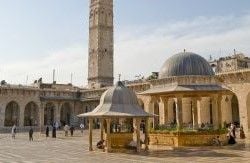Why Oxford archaeologists dream of seeing the Palmyra Arch rebuilt by Syrians.
As Islamist militants are driven finally out of their captured strongholds, Oxford archaeologists have urged that the restoration of damaged historic sites be made a priority.
 Aleppo, Umayyad (Great) Mosque courtyard in 2011.
Aleppo, Umayyad (Great) Mosque courtyard in 2011.When so-called Islamic State (IS) seized Palmyra in 2015, its militants beheaded the Syrian city’s 82-year-old archaeologist Khaled el-Asaad and destroyed the Temple of Bel that had stood there for 2,000 years, followed by the 1,800-year-old Roman Arch of Septimius Severus nearby. As international public outcry seemed to condemn the iconoclastic destruction more than the murder, ‘compassion fatigue’ was blamed. It is a debate that resurges every time historic heritage is blasted by war. But Oxford archaeologists and historians argue that it is misguided to weigh lives and buildings against each other like this.
‘The built environment is part of people’s identity,’ said Oxford classical archaeologist Dr Judith McKenzie. ‘Historic buildings are part of people’s culture, history, and memories. And handing down cultural heritage from past to future generations reaffirms identity.’ This is not a matter simply of bricks and mortar, but what she called ‘intangible heritage’ – the value that people and buildings have mutually generated across time.
Article written by John Garth (www.johngarth.co.uk)